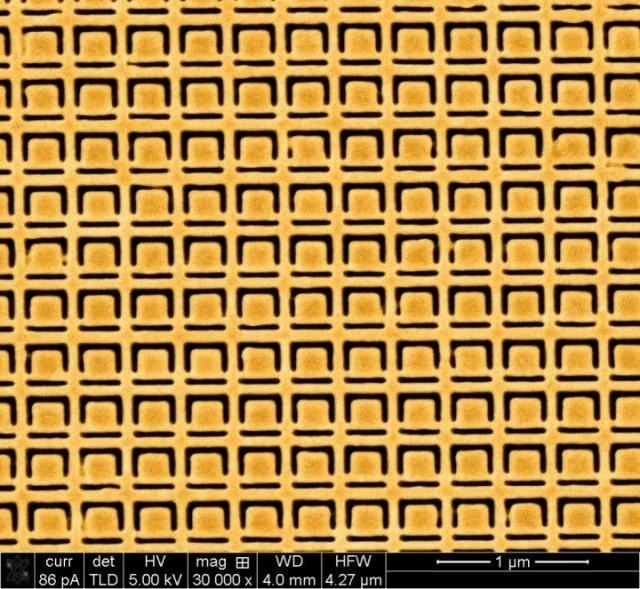Apr 7 2016
What happens if the symmetry of metamaterial is broken by the direction of illumination rather than by the material itself? Curiosity surrounding this question led a team of researchers from the University of Southampton to discover a new type of optical activity. The researchers have published their findings in Applied Physics Letters, from AIP Publishing.
 What happens if the symmetry of metamaterial is broken by the direction of illumination rather than by the material itself? Curiosity surrounding this question led a team of researchers from the University of Southampton to discover a new type of optical activity. The researchers have published their findings in Applied Physics Letters, from AIP Publishing.
What happens if the symmetry of metamaterial is broken by the direction of illumination rather than by the material itself? Curiosity surrounding this question led a team of researchers from the University of Southampton to discover a new type of optical activity. The researchers have published their findings in Applied Physics Letters, from AIP Publishing.
When metamaterial symmetry is broken with reflected light, it has potential for new applications as it promotes optical activity of exceptional magnitude. This is beyond the previously known "mirror-like" or specular optical activity.
The key feature in this study is metamaterials that possess novel symmetries and shapes. They are capable of producing properties that were never witnessed in their natural counterparts.
Natural materials derive their properties from the atoms, ions, or molecules they consist of. Similarly, the basic concept behind metamaterials is to assemble artificial materials from 'metamolecules,' which are manmade elementary building blocks. This provides a huge technological opportunity," Plum pointed out. "Instead of being limited by available natural materials, we can design materials with the properties we want. This has already led to the demonstration of various enhanced and novel material properties and functionalities.
Eric Plum, Research Lecturer, Optoelectronics Research Centre and Centre for Photonic Metamaterials, University of Southampton
Metamaterials appear homogenous in electromagnetic waves as the size of their artificial structure is subwavelength. Basically, metamaterials for light are developed on the nanoscale, while those for microwaves are developed on the scale of centimeters or millimeters.
The team is focused on the twisted, or "chiral," structures that exist within several natural and artificial materials, as they possess the ability to rotate transmitted light’s polarization. This property is referred to as optical activity, and forms the foundation for many applications, including LCD displays and spectroscopy. It can even be applied to detect life during space missions.
The team discovered that metamaterials varied from natural materials in yet another way, as the optical activity for light reflected by natural materials is insignificant. However, this is not true for metamaterials.
Our metamaterial exhibits huge optical activity for reflected electromagnetic waves. This is particularly remarkable considering that our artificial structure is extremely thin--30 times thinner than the wavelength of the electromagnetic radiation it manipulates.
Eric Plum, Research Lecturer, Optoelectronics Research Centre and Centre for Photonic Metamaterials, University of Southampton
Another surprising feature is that the optically active material involved is not really chiral.
Instead, optical activity arises from a chiral experimental arrangement associated with the mutual orientation of the direction of the illumination and the structure of the metamaterial, which lacks two-fold rotational symmetry. [This discovery shows promise for] a whole new class of extremely thin and light devices for controlling and detecting the polarization of light, such as polarization rotating and circularly polarizing beam splitters and mirrors, as well as optical isolators for circularly polarized light.
Eric Plum, Research Lecturer, Optoelectronics Research Centre and Centre for Photonic Metamaterials, University of Southampton
The team’s observation imitates the longitudinal magneto-optical Kerr effect, where the light reflected from a magnetized surface can alter in both polarity and reflected intensity without a magnetized medium.
This has significant implications for Kerr microscopy, because it could be mistaken for magnetization.
Eric Plum, Research Lecturer, Optoelectronics Research Centre and Centre for Photonic Metamaterials, University of Southampton
Plum and his team are working to produce realistic solutions to allow active control of specular optical activity for active polarization modulation.
It would also be interesting to study the effect in natural materials and to explore the consequences of similar types of 'symmetry breaking' of other physical systems.
Eric Plum, Research Lecturer, Optoelectronics Research Centre and Centre for Photonic Metamaterials, University of Southampton